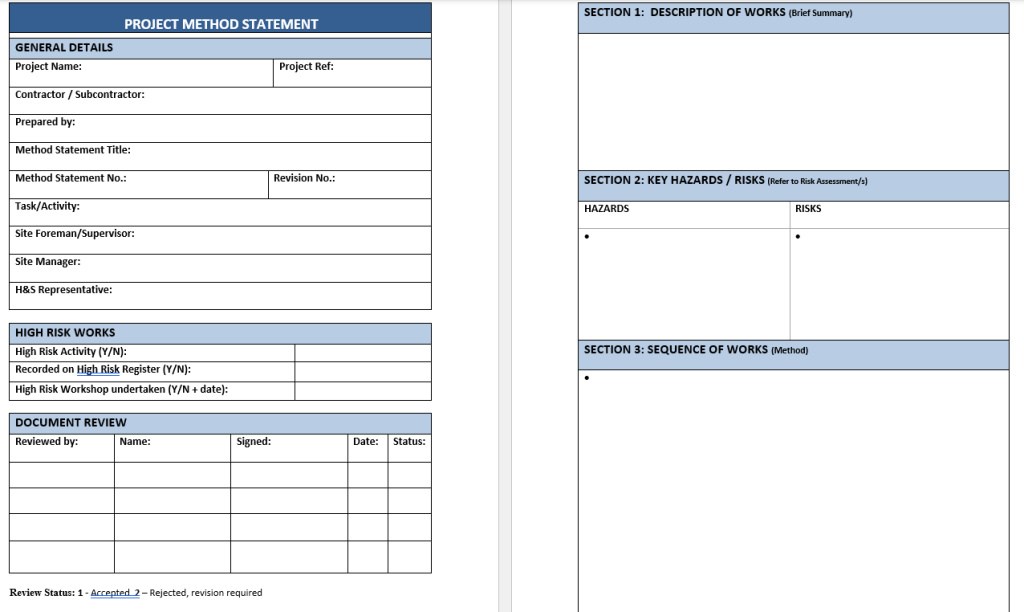Discover how RAMs in construction are revolutionising project safety and efficiency, transforming the way we manage building site risks
Understanding RAMS: The Foundation of Construction Safety
In the dynamic world of UK construction, Risk Assessment and Method Statements (RAMS) have become an indispensable cornerstone of project management and site safety. These comprehensive documents serve as the blueprint for identifying, assessing, and mitigating potential hazards while providing clear methodologies for executing construction tasks safely. Recent studies indicate that construction sites implementing robust RAMS protocols have seen a 45% reduction in workplace incidents, highlighting their crucial role in modern construction practices.
The Two Essential Components of RAMS
1. Risk Assessment: Identifying and Evaluating Hazards
Risk Assessment forms the analytical foundation of RAMS, involving systematic evaluation of potential hazards and their associated risks. This process requires careful consideration of various factors, including:
- Identification of potential hazards specific to each construction task
- Assessment of risk likelihood and potential severity
- Evaluation of existing control measures
- Determination of additional safety requirements
- Documentation of findings and recommendations
2. Method Statements: Creating Clear Safety Protocols
Method Statements translate risk assessments into practical, step-by-step procedures that guide workers through safe task execution. According to HSE guidelines, effective method statements must include:
- Detailed description of the work to be undertaken
- Sequence of operations and timeline
- Required plant, equipment, and materials
- Specific safety measures and PPE requirements
- Emergency procedures and contact information
Why RAMS Matter in Modern Construction
Legal Requirements and Compliance
In the UK construction industry, RAMS are not merely best practice but a legal requirement under various regulations, including the Health and Safety at Work Act 1974 and the Management of Health and Safety at Work Regulations 1999. Companies failing to maintain proper RAMS documentation face penalties of up to £20,000 per incident, with more severe breaches potentially resulting in unlimited fines or imprisonment.
Project Management Benefits
- Enhanced project planning and resource allocation
- Improved communication between stakeholders
- Reduced insurance premiums through demonstrated risk management
- Better cost control through accident prevention
- Increased client confidence and satisfaction
Creating Effective RAMS Documents
Essential Elements of Risk Assessment
A comprehensive risk assessment must consider five key elements:
- Hazard identification and classification
- Who might be harmed and how
- Risk evaluation and existing control measures
- Additional controls required
- Regular review and updates
Crafting Comprehensive Method Statements
Method statements should be clear, concise, and practical, incorporating all necessary information for safe task execution. Research shows that well-written method statements can reduce workplace accidents by up to 70%. Key components include detailed work procedures, required resources, and specific safety measures.
Implementing RAMS on Construction Sites
Training and Communication
Successful RAMS implementation relies heavily on effective training and communication strategies. Site managers must ensure that:
- All workers receive comprehensive RAMS training
- Documentation is readily accessible and understood
- Regular toolbox talks reinforce safety procedures
- Clear communication channels exist for reporting concerns
- Language barriers are addressed through appropriate translations
Monitoring and Updates
RAMS documents are living documents that require regular review and updates. Industry best practice recommends reviewing RAMS documentation at least quarterly, or whenever significant changes occur in work processes or conditions.
Common Challenges and Solutions
Overcoming Implementation Hurdles
Construction companies often face various challenges when implementing RAMS, including resistance to change, time constraints, and resource limitations. Successful implementation requires:
- Clear leadership commitment and support
- Adequate resource allocation
- Regular training and reinforcement
- Efficient documentation systems
- Positive safety culture development
Best Practices for Success
To maximise the effectiveness of RAMS implementation, construction companies should follow these proven strategies:
- Involve workers in RAMS development and review
- Use digital tools for documentation and distribution
- Maintain consistent monitoring and feedback systems
- Regular updates based on site experiences and lessons learned
- Integration with broader safety management systems
The Future of RAMS in Construction
Digital Integration and Innovation
The construction industry is witnessing a digital transformation in RAMS management. By 2024, 75% of UK construction firms are expected to adopt digital RAMS solutions, incorporating features such as mobile access, real-time updates, and automated compliance tracking.
Evolving Safety Standards
As construction techniques and technologies advance, RAMS requirements continue to evolve. Future trends include:
- Integration with Building Information Modelling (BIM)
- Artificial intelligence for risk prediction
- Wearable technology for real-time safety monitoring
- Enhanced environmental consideration in risk assessments
- Greater emphasis on mental health and wellbeing
Conclusion: Maximising Site Safety through Effective RAMS
RAMS remain fundamental to construction safety and project success in the UK. By understanding and implementing these essential documents effectively, construction professionals can create safer workplaces, improve project outcomes, and ensure regulatory compliance. As the industry continues to evolve, the integration of digital technologies and innovative approaches will further enhance the effectiveness of RAMS, making construction sites safer and more efficient than ever before.
FAQ
Is RAMS a risk assessment?
RAMS stands for Risk Assessment Method Statement — an important health and safety document that is completed to identify the steps to be undertaken to carry out a specific activity or task in a safe manner. RAMS can be utilised in conjunction with the risk assessment process.
How do RAMS work?
RAM provides the shorter-term memory the CPU needs to open files and move data around as it responds to the tasks given to it by your apps. Both RAM and the CPU work synchronously and complementarily to ensure that your computer’s performance fits your needs and you have a good experience when using your device.
What is the role of RAMS engineer?
RAMS engineering plays a crucial role in ensuring the reliability and safety of aerospace systems. From designing aircraft components to managing their lifecycle, RAMS principles guide engineers to create systems that perform consistently, maintain functionality, and minimize risks.
What is RAMS in engineering?
The RAMS (Reliability, Availability, Maintainability and Safety) disciplines are a set of tools that make it possible to ensure that a product, process or system fulfils the mission for which it was designed, all under the conditions of reliability, maintainability, availability and well-defined safety.
What is the reason for RAMS?
In summary the purpose of RAMS is to ensure health and safety, identify hazards and risks associated with a task (etc) and provide suitable and sufficient control measures to control risk assessment and further provide a safe system of work/step-by-step instructions to persons carrying out the task etc. to mitigate the …
Sources
[1] https://humanfocus.co.uk/blog/what-are-rams-in-construction/
[2] https://www.chas.co.uk/blog/method-statement-contents/
[3] https://www.hsa.ie/eng/your_industry/construction/besmart_ie_for_construction/risk_assessment_method_statement_rams_template_and_guidance/


Leave a Reply